Serbia’s path to Group C of the 2024 UEFA Men’s Euro wasn’t as easy as expected, considering the number of star players in their squad.
The two defeats against Hungary and two ties with Bulgaria weren’t in Dragan Stojković’s qualification plans and made their future uncertain.
However, the Eagles finished second and secured their participation in the tournament.
They will face the Euro 2020 finalists and semi-finalists England, Denmark, and Slovenia.
While the rest of the teams in Group C are on a good run, Stojković’s side have been pretty inconsistent in the last calendar year, just as their starting XI was.
Despite most of the players competing in the top European leagues, the manager couldn’t seem to find the right partnerships in order to achieve more consistent results.
Between the European championships, Serbia qualified for the 2022 FIFA World Cup; however, after an unconvincing performance, they got eliminated in the group phase.
Our tactical analysis includes a scout report on the Eagles’ Euro 2024 squad and examines their set-up and playing style.
Serbia Starting XI
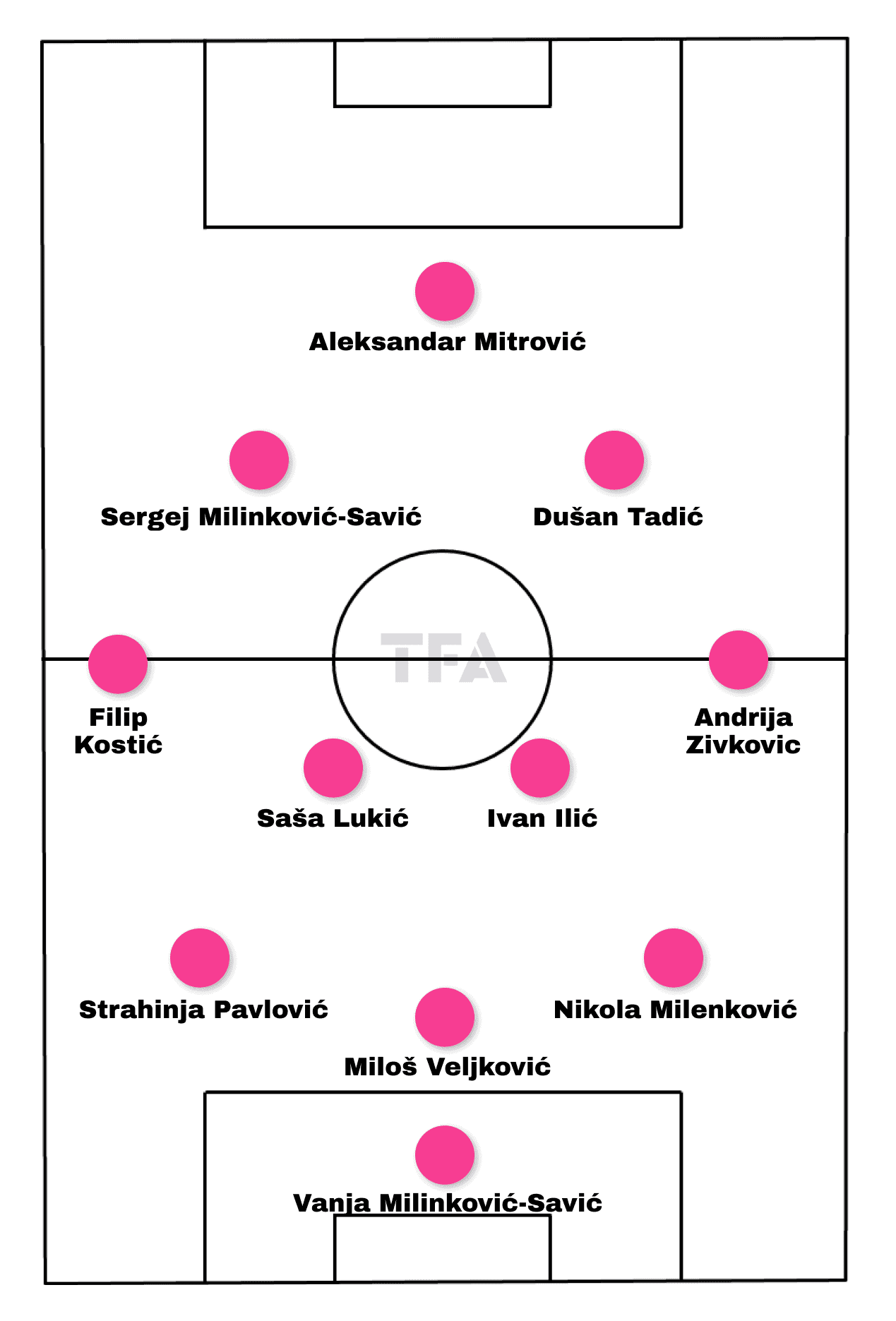
The manager’s favoured setup is 3-4-2-1, although he frequently switches between formations, making his starting XI unpredictable.
He also relies on frequent positional interchanges, especially when making his substitutes.
He prefers playing with a back-three where the team would aim to gain control in the middle third through a highly positioned backline and forwards who would drop deep.
Stojković’s first-choice goalkeeper will be Vanja Milinković-Savić.
He played throughout the qualifications, and it is expected that the manager will rely on his strong decision-making and involvement in possession once again.
Srđan Babić’s injury made the decision on the defensive line-up more difficult, as he would have been the preferred option in the middle.
Considering the uncertainty around him, the back-three will consist of Strahinja Pavlović in the left centre-back position, followed by Miloš Veljković centrally and Nikola Milenković on the right.
The manager tends to do a lot of rotations in midfield, which is expected to be the case in the Euros as well.
That is why the starting line-up might change with the tournament’s progression.
Filip Kostić will start in the left wing-back/winger position as usual, although he might be switched for Filip Mladenović if the manager seeks better defensive coverage.
Andrija Živković has earned his starting spot on the right.
The manager rotates the central midfielders rather frequently, which makes predicting his preferences challenging.
One of his options is Sergej Milinković-Savić, although Stojković often uses him in a more advanced position behind the striker.
That is why Saša Lukić and Ivan Ilić will form the pair centrally, while he starts next to the veterans Dušan Tadić and Aleksandar Mitrović up front.
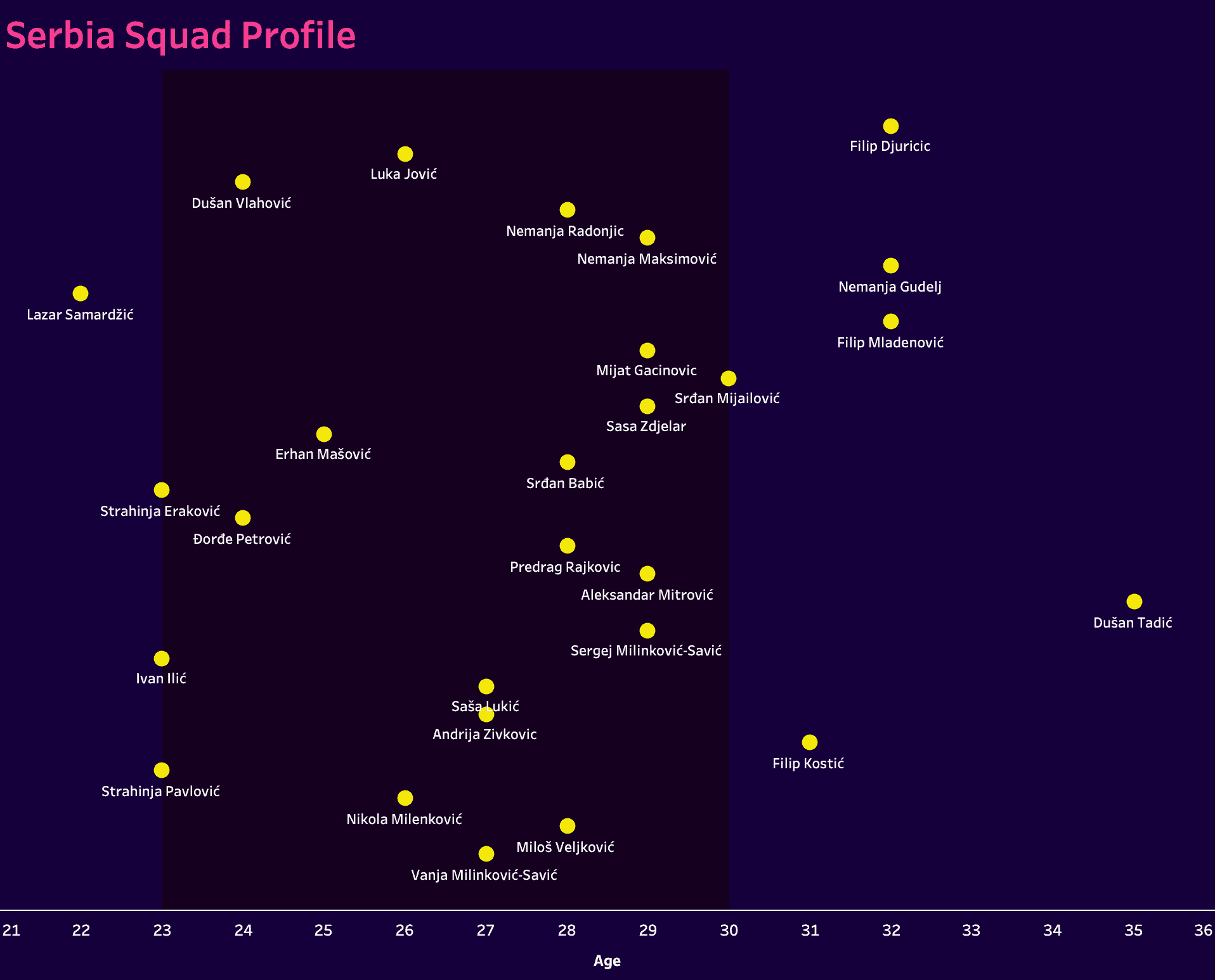
The plot above illustrates Serbia’s age profile, underlying Stojković’s choice of players in their prime who have already gained some experience.
There are a few players in their 30s who lay the foundations of the team.
Tadić, Kostić and Nemanja Gudelj are all key figures in the squad who they will have difficulties replacing after they retire from international football.
While Gudelj might be left out of the squad if he doesn’t recover from his injury, he will have a strong influence off the pitch.
Serbia Attacking Phase
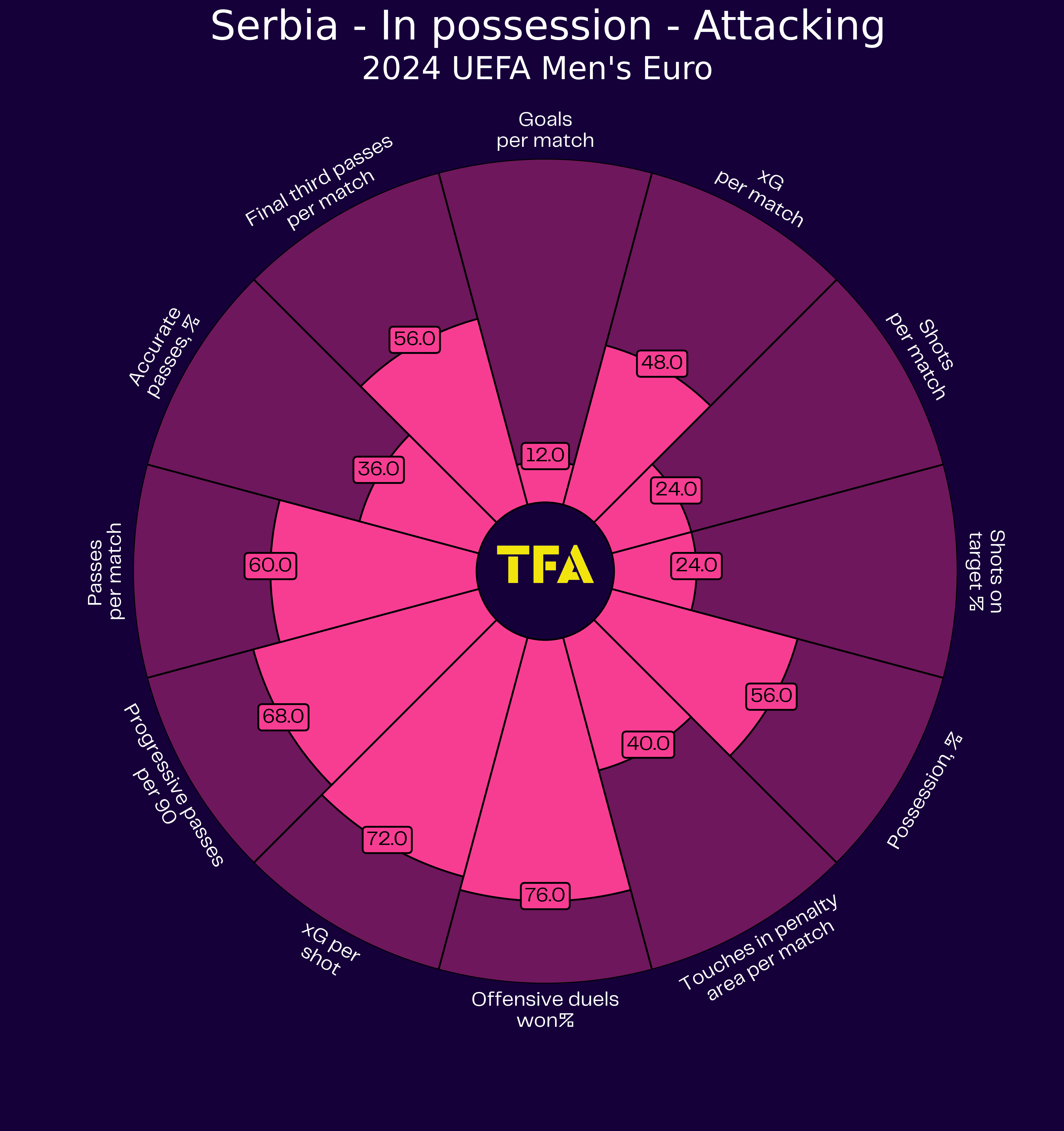
As illustrated in the chart above, Serbia’s attacking performance often doesn’t match their ambitions.
While the team prefer to dominate possession, they occasionally struggle to control the game due to their pass completion rate.
The inconsistency of their passing makes it difficult to create quality chances on the goal.
As shown, their pass accuracy is considerably low compared to the qualifications’ median, which affects not only their performance in the final third but also their defensive performance, as we will touch on in the next section.
Their failure to create many opportunities is partly due to their overreliance on crossing.
The players usually spread out wide and rely on link-up play to progress the ball.
Once they reach the final third, they aim to cross it.
However, due to the lack of balance in their movement and the lack of efficient exploitation of the central channels, they often become predictable and less versatile.
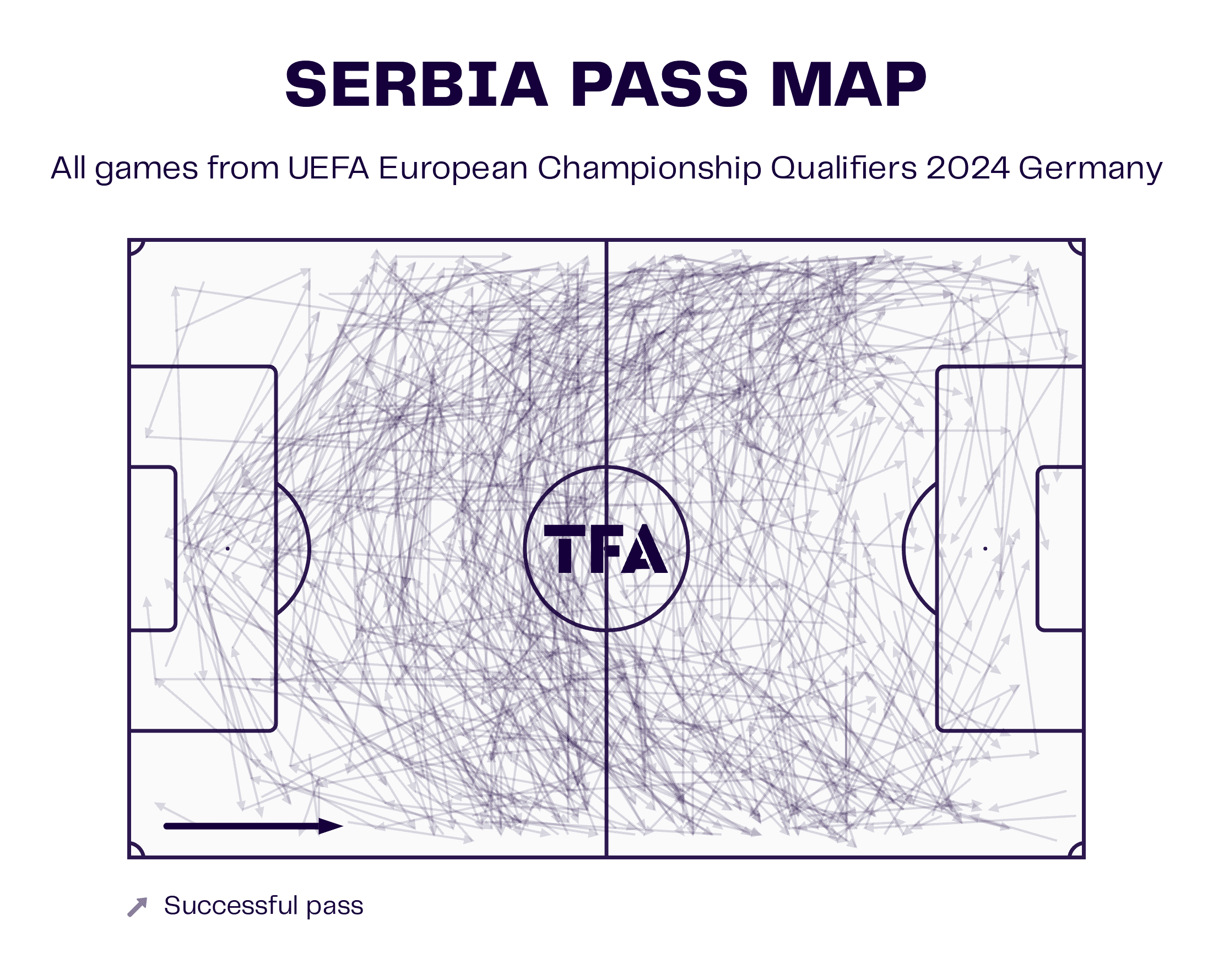
Their pass map confirms their rare use of the central areas for pass combinations in an effort to break the defence, as their passes are usually directed out wide.
Playing against teams that employ low block makes it even more difficult for them to penetrate despite the attacking players’ good positioning in the box.
However, they manage to take advantage of the players’ spatial awareness, as many of their goals have come after set-piece opportunities as they succeed in outplaying the opposition in the box.
Serbia Defensive Phase
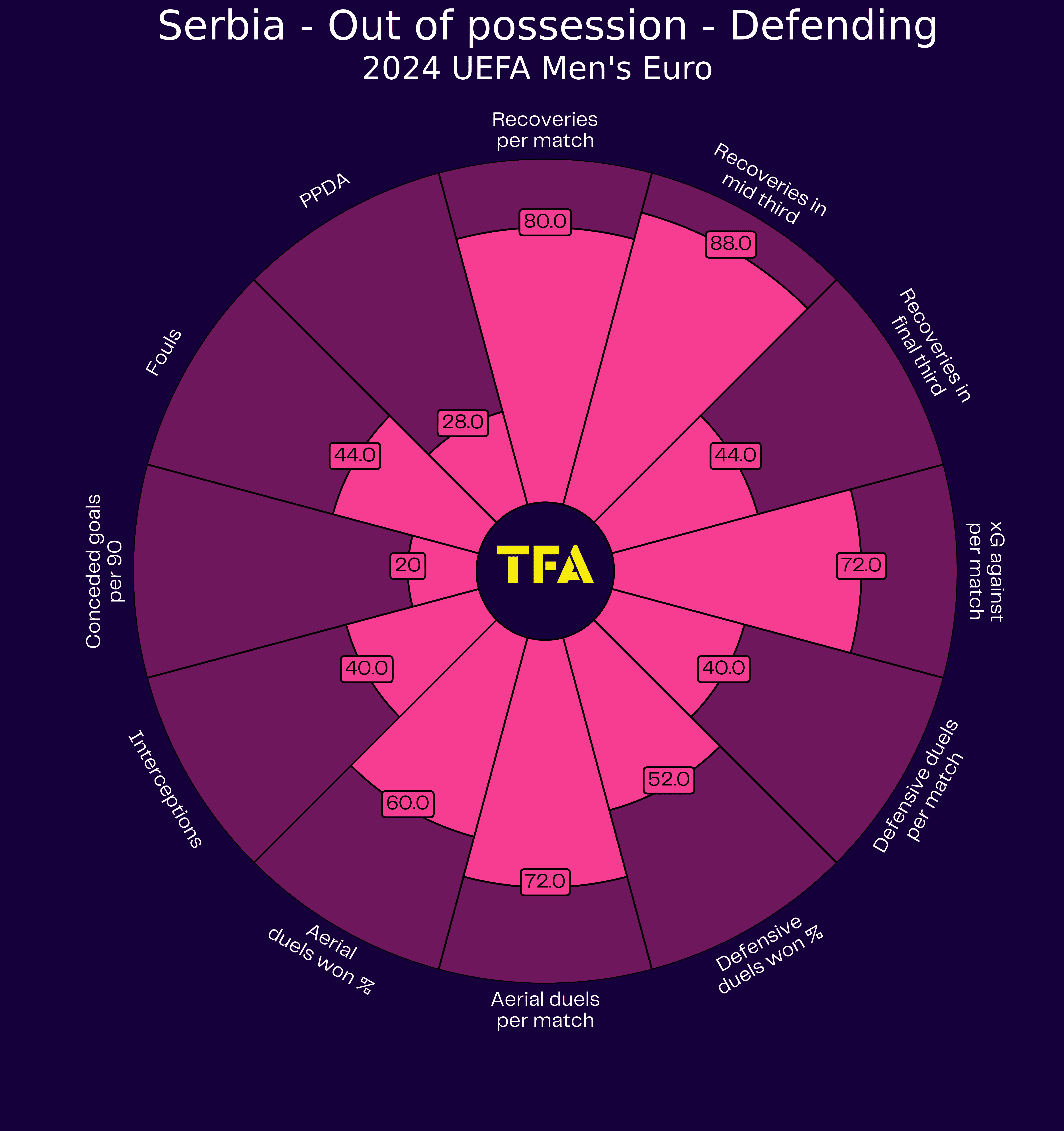
As mentioned, their passing inaccuracy also affects their defensive performance.
With a highly positioned defensive line, they are prone to being exposed on a counter should they lose the ball.
They often struggle to transition back after losing possession, which results in being outnumbered and conceding.
They recover the ball most frequently centrally, not risking it all with high pressing and completely moving out of their half, but they still concede quality chances due to their compact shape.
The backline usually moves close to the central line while the attackers drop back, which creates a compact passing network.
However, it makes them more vulnerable during transitions.
Their press intensity appears high due to their active counter-pressing efforts.
If they lose possession in the final third, they immediately push the opposition back and aim to regain the ball.
The team occasionally fail to cover some areas due to being overcommitted to the ball carrier’s side.
That allows their opponents to switch play and exploit the empty spaces, which often leads to conceding dangerous chances.
Serbia Transitions
Serbia’s back three would usually stay high, right behind the central line, and retain possession by circulating the ball between each other and the goalkeeper.
The team’s compact shape, with the forwards dropping into deeper positions, gives them the chance to dominate possession in the middle third.
Below, the keeper receives the ball from the backline and draws pressure so he can free up some space to progress the ball.
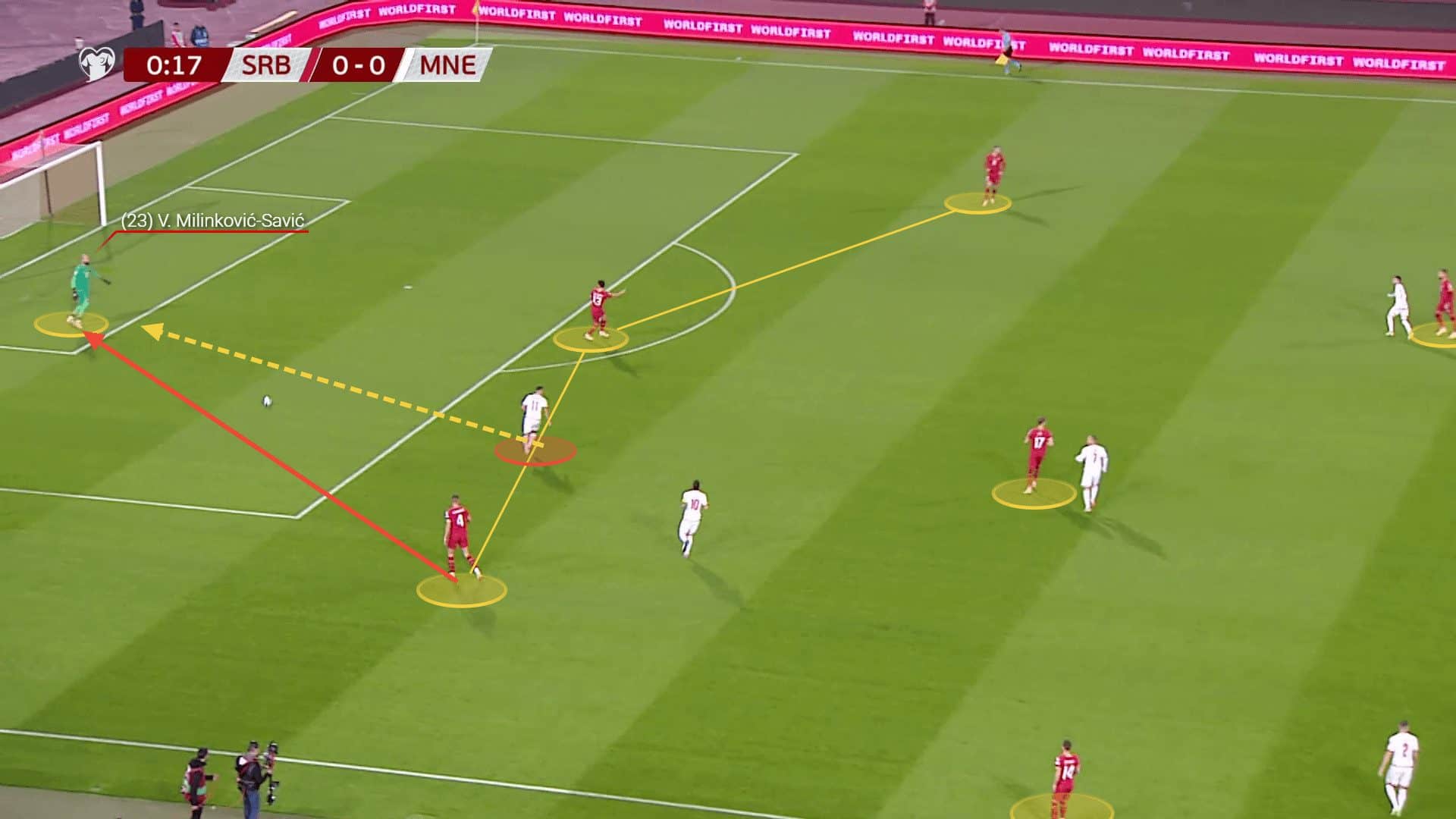
They try to establish control by overloading in these areas and then progressing the ball by spreading out wide to the flanks.
However, as mentioned, they are prone to mistakes and lose possession rather often.
The players commit individual errors under pressure, which often lead to conceding shots or penalties.
The team frequently lose the ball after inaccurate passes, which then turns into quick turnovers.
The defence’s high positioning, combined with the overall compactness and their overcommitment to pressing the ball carrier, results in leaving gaps, which can easily be exposed through long balls behind the defence.
They often find themselves behind during defensive transitions, and the players fail to cover depth in case any of the defenders is out of position.
The following sequence shows an example of how their high positioning and overcommitment to marking the player with the ball can result in being exposed through a long ball.
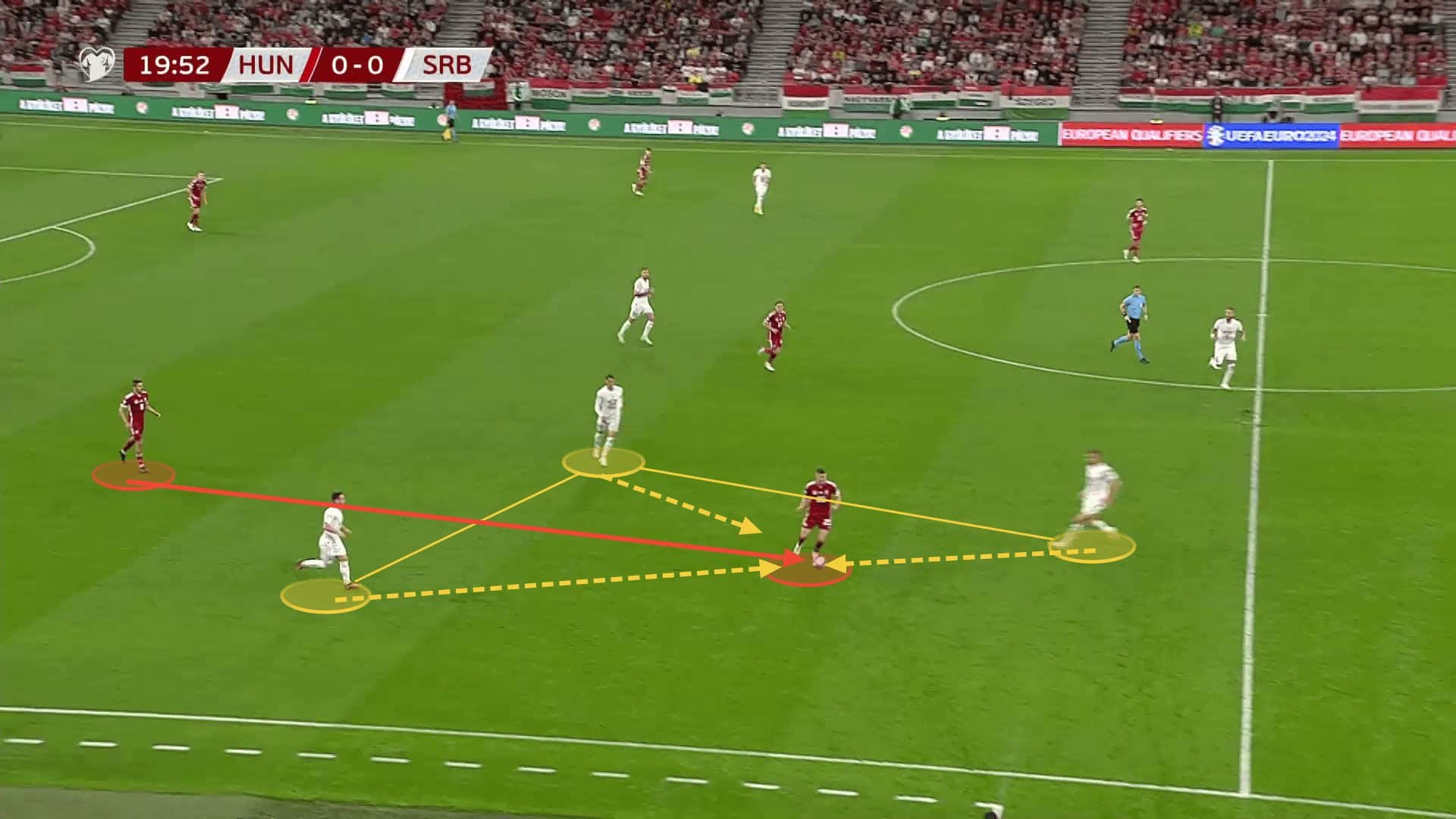
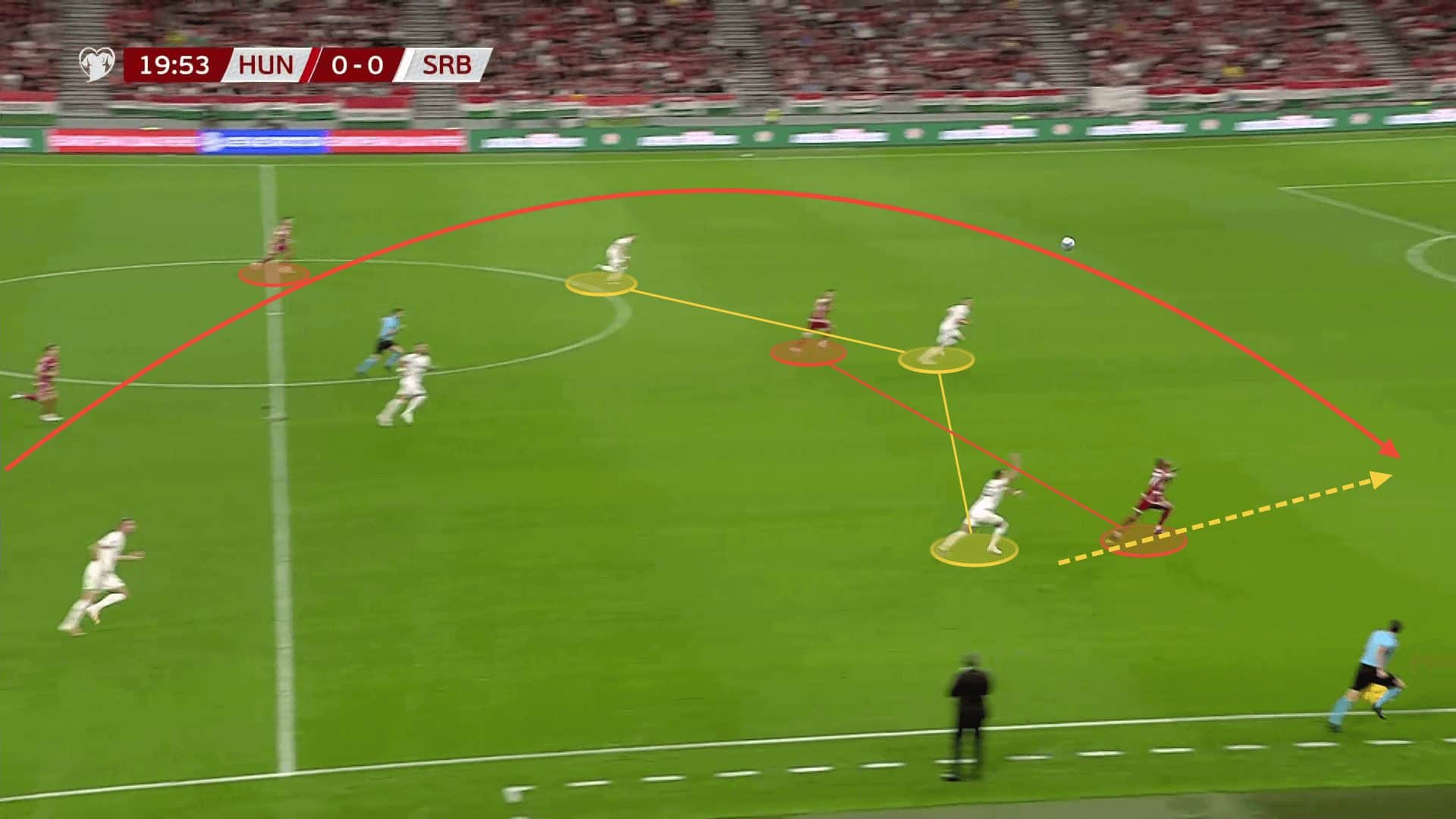
Serbia Forwards
Stojković can choose between a few quality options up front.
His first-choice striker is Mitrović, who has proven an important figure in the squad.
The 29-year-old is the country’s all-time leading goalscorer with 57 goals in 89 appearances, followed by another regular starter, Tadić (22 goals in 106 games).
Mitrović is valuable due to his ability to sneak into the penalty area and his finishing.
His strong right foot and heading attempts are the reason for many of the attempted crosses by his teammates.
As his shot map underlines, his late runs and smart positioning allow him to shoot from quality areas and increase his chances of scoring.
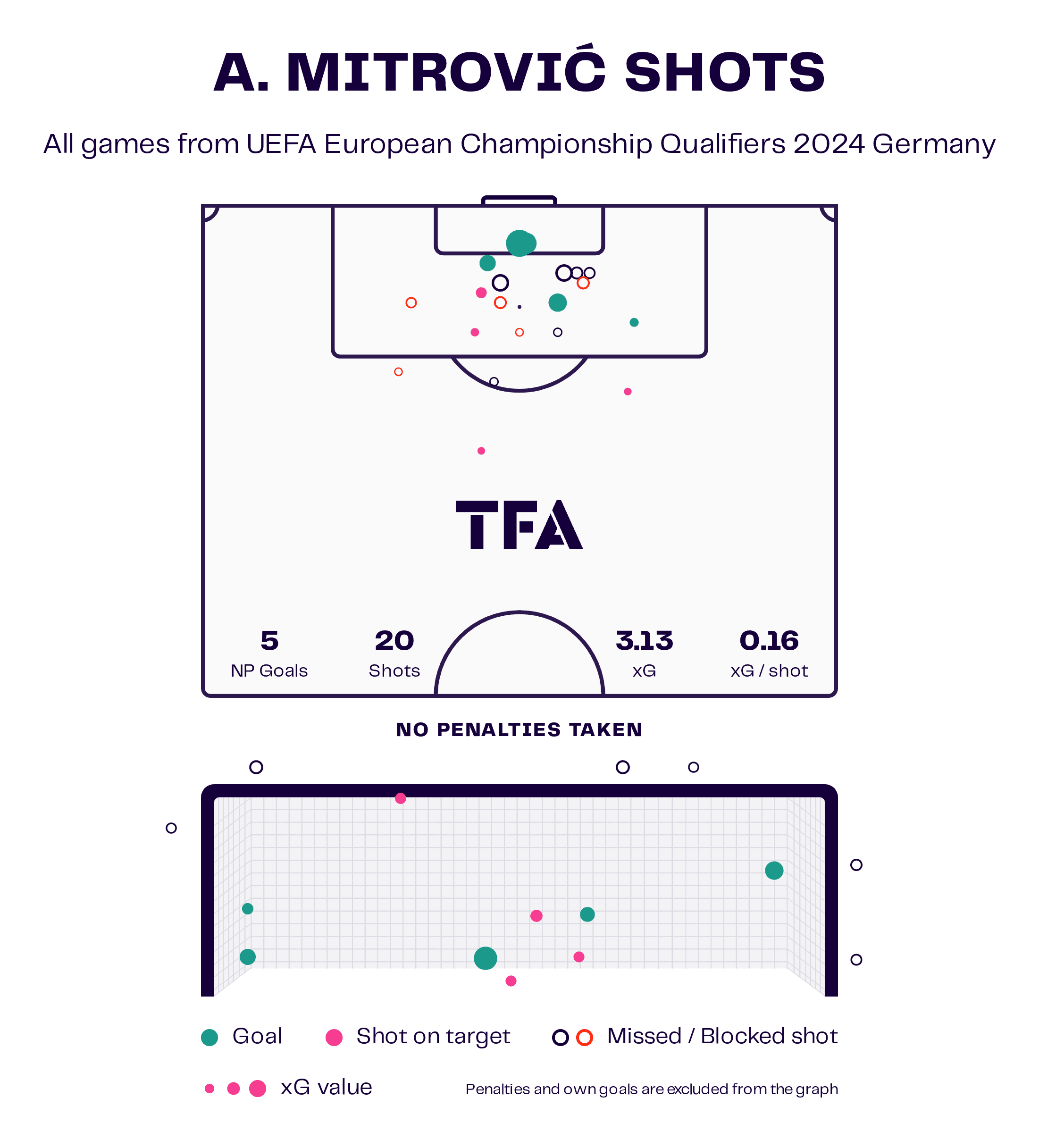
Tadić, on the other hand, supports the attacking play through his passing range and tactical intelligence.
He can equally well send a through ball, cross it, or make a one-two.
Additionally, he poses a direct threat to the goal.
The other weapon the Eagles have up front is Dušan Vlahović.
The Juventus player had another successful season in Serie A, but despite that, he is yet to fully replace Mitrović in the starting XI.
He will most certainly receive more playing opportunities during the tournament as his pace, positional sense, and shots from distance bring another dimension to Serbia’s performance in the final third.
Luka Jović made an impact as a substitute multiple times for Milan this season and is expected to do so for Serbia, too.
Filip Đuričić’s experience could also be used in a supporting position behind the striker.
Nemanja Radonjić also has experience as a centre-forward; however, his usual role is as a winger, and Stojković might use him as a replacement in the wing-back position.
Serbia Midfielders
The midfield line-up is the most unpredictable in terms of starters.
The manager constantly rotates players, and now, with Nemanja Gudelj’s possible absence, he has to make difficult decisions on the correct partnerships centrally.
Kostić has secured his spot in the left wing-back position thanks to his link-up-play and sufficient crossing.
Živković will cover the flank on the right and support the team during transitions.
His passing range and ability to hold on to the ball are essential for their successful ball progression, while he brings balance by dropping back and supporting the defensive line.
Filip Mladenović is Kostić’s possible replacement, especially when in need of defensive reinforcement.
Another option for the wide areas is Mijat Gaćinović.
The next image is an example of their link-up play on the flank.
Živković has moved out to support his teammates on the other side of the pitch.
His off-the-ball movement provided Kostić with a passing option.
He received the ball, which allowed Kostić and Lukić to move further.
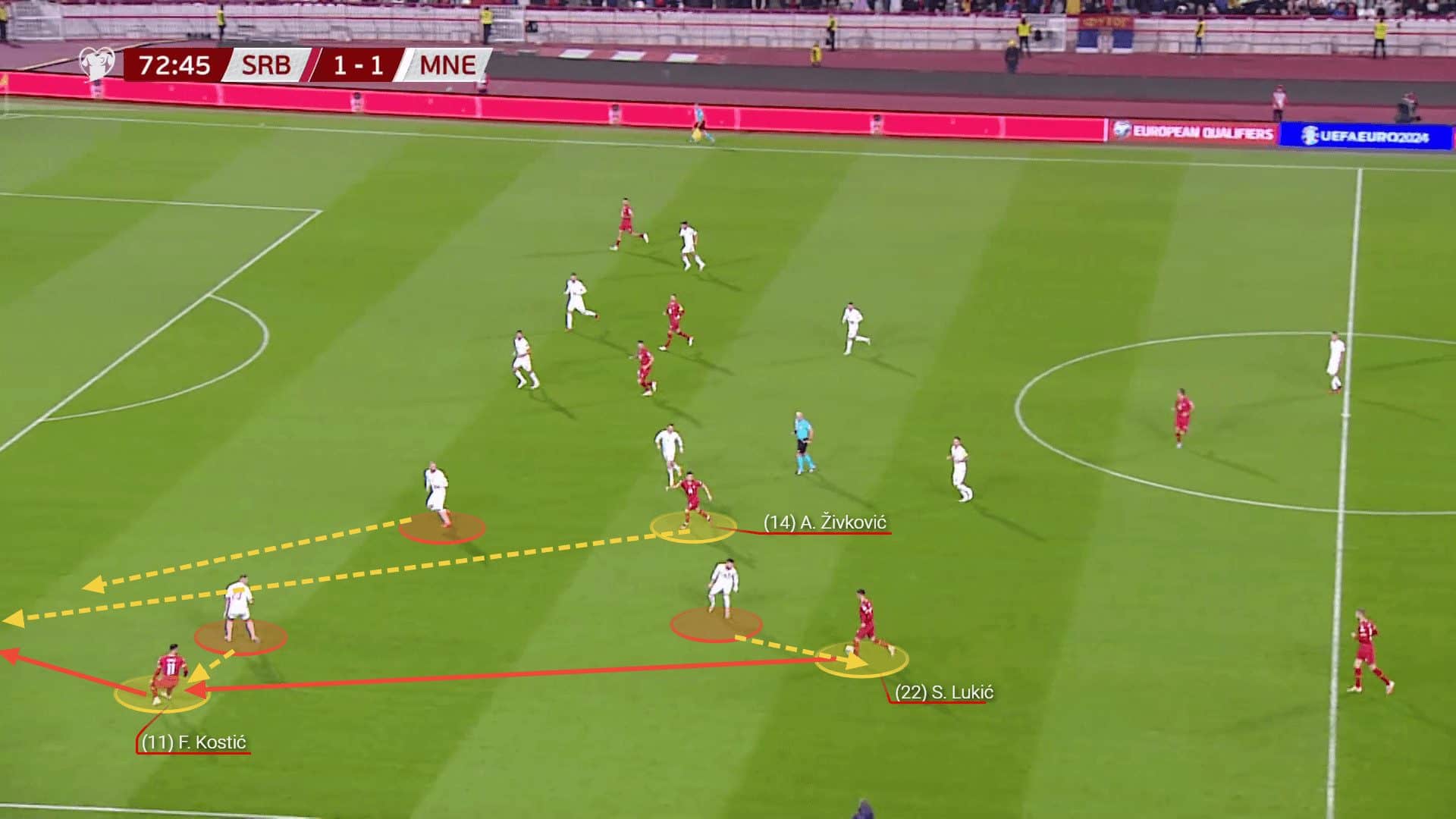
Nemanja Gudelj, who is one of the team’s regular starters and leaders, got injured at the end of April and underwent surgery.
It is doubtful if he will be fit enough to get some playing minutes.
The Serbian went back to full training with Sevilla, which increased the hopes that he could play for his country in the European championship.
Despite the uncertainty around his recovery, his influence on the team is important, and the manager will most probably save him a spot in the squad in hopes of getting him up and going at some point in the tournament.
Until then, the RCMF position will be covered by Ivan Ilić, whose passing range fits the team strategy well.
Saša Lukić will most probably earn the other centre midfield spot, although this one is tricky due to the presence of Sergej Milinković-Savić.
While he would usually play in this spot, Stojković often uses him as a second attacking midfielder behind the striker.
Hence, he will form the attacking trio with Mitrović and Tadić.
He provides an indirect threat to the goal, and his passing abilities support his teammates’ movement successfully.
Here’s an example of Milinković-Savić’s successful movement.
He provided a passing option for Kostić with his run to the edge of the box.
The winger’s precise pass in behind the defence set Milinković-Savić up perfectly, and he eventually scored.
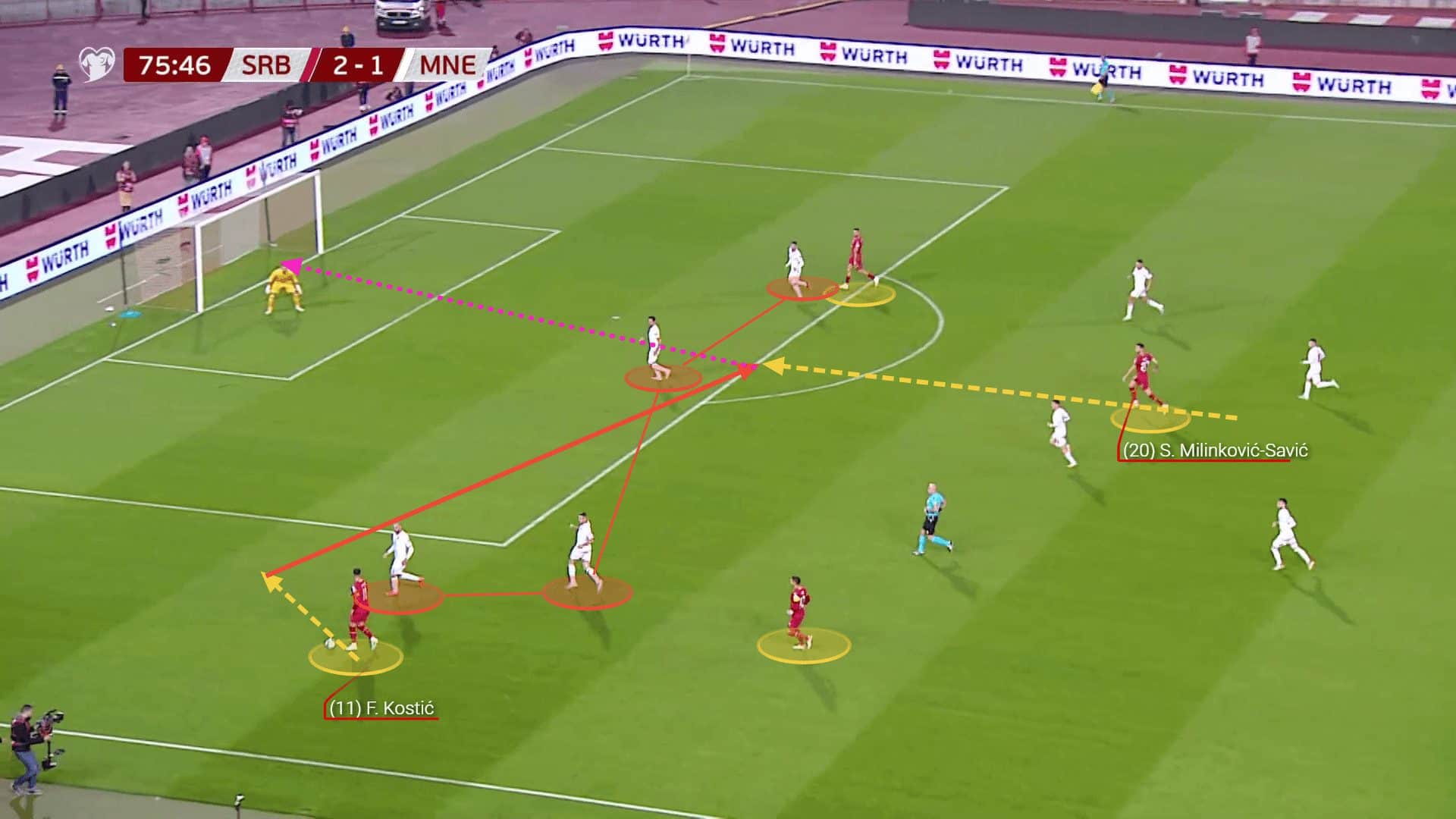
The coach usually relies on versatile players who can cover multiple positions if needed.
Players like Lazar Samardžić provide many options as he can play in centre midfield, on the flank and in the attacking midfield as well.
Stojković will bring a couple of more deep-lying players in the face of Srđan Mijailović and Saša Zdjelar.
Serbia Defenders
Serbia’s three-man defensive line will consist of Pavlović, Veljković and Milenković, who will be supported by Vanja Milinković-Savić between the posts.
Pavlović has a high impact both in and out of possession due to his aerial presence and accurate defensive actions, which he combines well with composure and ability to hold on to the ball.
While the three of them work well together, they are all prone to often committing fouls, which might impact Serbia negatively, especially considering the pressure they will sustain.
The manager will bring Strahinja Eraković as a backup option in defence, too.
His high pass accuracy helps for smoother transitions and decreases the number of errors under pressure.
Babić might be included in the squad despite his injury, as he provides additional defensive stability, similar to Erhan Mašović.
The other goalkeeper options are Predrag Rajkovic and Đorđe Petrović, who both had successful seasons at club level in terms of individual performance.
Serbia Key Player
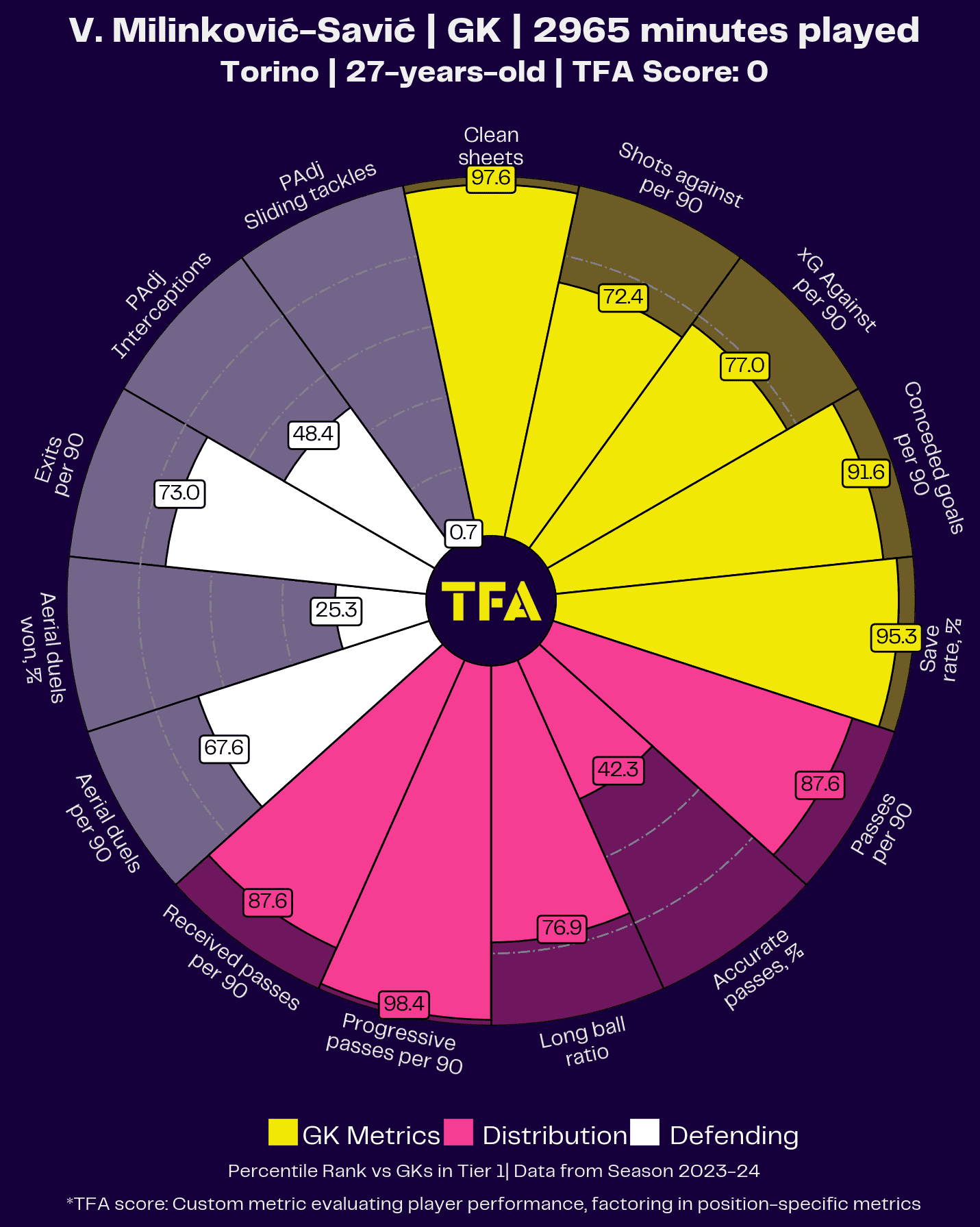
Many would consider players like Mitrović or Vlahović as the key players for Serbia in the Euros, and their importance is undeniable indeed.
However, the goalkeeper Vanja Milinković-Savić deserves to go under the radar.
He has been one of the most regular starters for his country, not because there is no competition for the spot, but because of his qualities.
His 2023/24 Serie A performance chart for Torino underlines his impact in and out of possession.
Despite the team’s inconsistent performance and finish in the middle of the table, some details cannot go unnoticed.
With the support of the defensive line, Milinković-Savić is the second-best goalkeeper in terms of clean sheets in the league.
Despite Torino’s struggles to avoid individual errors and to defend efficiently around the box, the 27-year-old pulled off many crucial saves during the last campaign.
His contribution in possession is equally as important.
His chart shows that he is actively involved in ball retention and progression through his passing.
Not only does he have a solid passing range, but he also constantly provides his teammates with a passing option to circulate the ball and bypass the press.
Serbia Tournament Prediction
As our analysis shows, Serbia will find it difficult to advance to the round of 16, considering the competition in the group.
While they do have chances to finish second, with more experience in big competitions and star-studded squads, England and Denmark are the favourites for the first two spots.
Their current state of considerably low attacking efficiency and some crucial mistakes defensively make the third spot seem attractive.
If they are among the best four third-placed teams, it might give them the ticket for the next round.

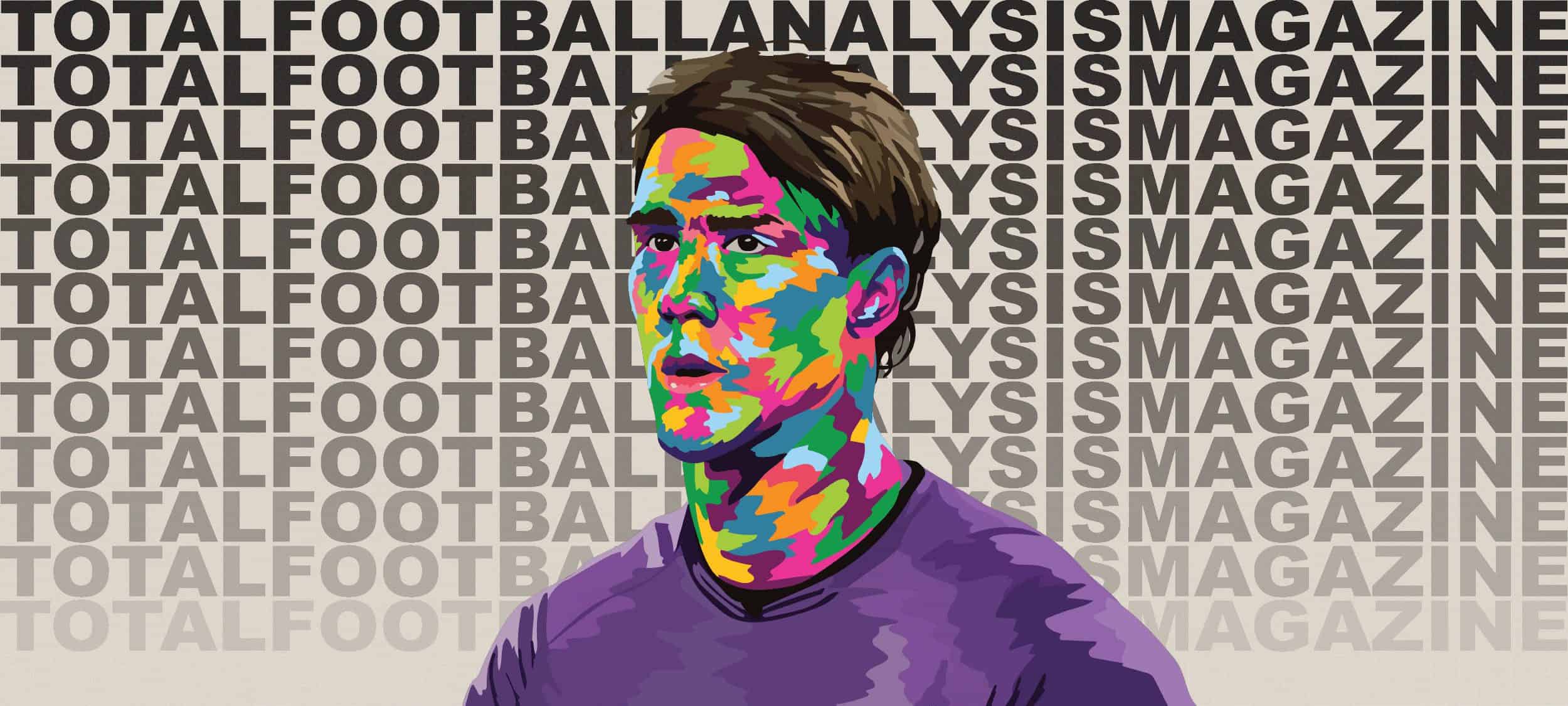




Comments